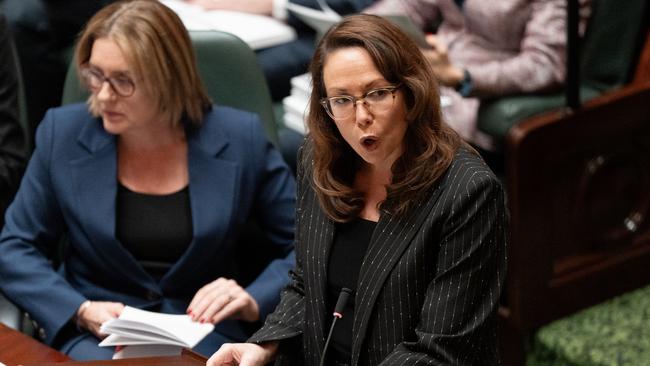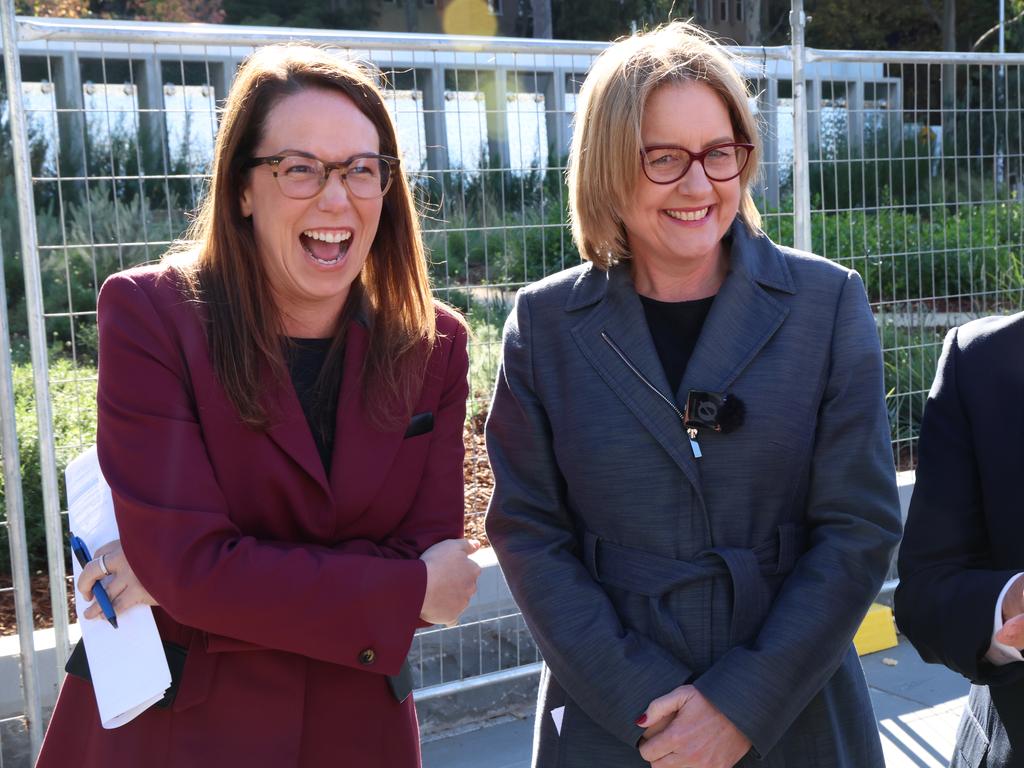Victoria’s debt and tax spiral confirmed by budget
Despite the Allan government’s commitments to ‘fiscal discipline’ departments are blowing their budgets and the cost of the public service continues to escalate.

Victoria’s debt and tax spiral has escalated as departments blow their budgets, Labor’s borrowing binge continues and public service expenses soar, prompting a warning from a global ratings agency ahead of next year’s state election.
In the wake of Tuesday’s state budget that confirmed state debt will hit $194bn within four years taking the state’s annual interest bill to $10.5bn, the Allan Government has been put on notice by S&P Global who said “fiscal discipline” was required to control operating costs, deliver savings and slow growth in debt.
While S&P Global — which downgraded Victoria two notches from triple-A to AA in 2020, increasing the cost of borrowings — said the state’s fiscal outlook was “slowly improving after several years of yawning deficits and rapidly rising debt” the government needed to show budget restraint leading into the 2026 Victorian election.
“Reining in growth in public spending, including the government’s wage bill, and achieving promised operating savings are key to strengthening its financial outcomes,” S&P Global analyst Rebecca Hrvatin said, noting the state “tends to channel additional revenue into further spending”.
“However, these goals have proven to be difficult to achieve in recent years. Fiscal discipline is important, especially in the lead up to the 2026 state election because we have seen many Australian state governments lose control of their budgets in the lead-up to an election.”
Another global ratings agency, Moody’s, also noted that “the state’s goal of stabilising the debt burden and ultimately bringing it down will likely remain challenging without even stronger revenue growth, more restrained spending and sustained momentum on reform”.
Despite promises of cuts to public sector spending, Treasurer Jaclyn Symes’ first budget confirmed the state’s wages bill has blown out by billions of dollars from the last budget and will continue to increase, with an annual bill of $42bn forecast for June 2029. The government’s key departments also blew their budgets by a total of $7.5bn last year.
At the same time, the government continues to increase its taxes, with the budget revealing about a 30 per cent increase in taxation revenue from $36.8 billion 2023-24 to almost $48bn in 2028-29.
The budget reveals Victoria’s debt – currently sitting at around $155.5bn – is set to skyrocket to almost $200bn within four years, increasing to $167.6bn next year, $177.4bn in 2026-27, $185.2bn in 2027-28 and then $194bn in 2028-29.
Despite Ms Symes insisting the government had made “responsible choices”, by June 2029, it’s predicted that the state’s taxpayers will be paying a $10.564bn in annual interest, that’s about 9 per cent of total revenues.
Asked by The Australian if she was comfortable with spending so much of the state’s revenue on the repayments, Ms Symes said:
“By the end of the forwards, because our economy is strong, because it will grow, for a range of reasons… total interest will be 1.5 per cent of GSP in a year.
“Would I like it to be lower? Yes I would.”
The $10.5bn interest bill is more than an $8bn increase from a decade ago in June 2019 when the annual interest repayment bill was $2.1bn.
An average of 8 per cent of the state’s total revenue will need to be used paying off interest on the state’s debt over the forward estimates.
“Interest expense is forecast to grow to $7.6bn in 2025-26, and to $10.6bn by 2028-29, as the Government continues to support significant investment in the delivery of services and the infrastructure program,” the budget papers read.
Asked about debt levels, Ms Symes said they were a result of Labor’s infrastructure spending and Covid support schemes.
“We’ve invested in productive infrastructure and I saw some of that yesterday,” Ms Symes said. “Pretty amazing. That’s what people are going to say for years, the Labor government did things, the Liberals didn’t.”
Victorian Opposition Leader Brad Battin said Labor’s budget was full of “debt and deception” and slammed its public service wage bill blowouts and increasing tax take.
“They continue to mislead everyone in the community by putting out their forecasts, and they’re not living anywhere near it,” Mr Battin said of the public service wage cost blowouts.
“If you ran a business like this, you would be broke.”
Mr Battin warned the state’s mammoth interest bill would come at the cost of essential services.
“Each and every day we’re paying $29m in interest to cover what this government is going to have of nearly $200bn in debt,” he said.
“That is going to be over $1.2 billion each and every hour that has to be put into the budget to cover just the interest bill.
“This government has got their priorities all wrong.
“When you see an increase over a decade of 133 per cent on taxes here in this state, you know that this government’s lost control of the budget, and every single Victorian is paying the price.”
Despite Ms Symes identifying $3.3bn in public service cost savings informed by the outcome of an interim review into inefficiencies in the public service and saying there would be the equivalent of about 1200 full time equivalent jobs cuts, the budget reveals an increase in employee expenses.
Employee expenses – excluding superannuation - for 2024-25 and 2025-26 have blown out by more than $1bn from last year’s budget.
Forecast expenses for the 2026-27 has increased from $39.389bn to $39.838bn, while the bill is now forecast $41b in 2027-28, up from the $39.86bn forecast in last year’s budget.
Employee expenses – which are the state’s largest expense - will then hit $42.4bn in 2028-29.
The government expects 2.9 per cent per year in average growth of employee expenses, including superannuation, over the forward estimates, which it said was “consistent with the requirements of service delivery and enterprise bargaining agreements.”
This comes despite Ms Symes foreshadowing a shrink in employee expenses off the back of the interim report of a review into inefficiencies in the state’s public service, commissioned by Ms Symes and Victorian Premier Jacinta Allan in February.
At the time of announcing the review, Ms Symes said she expected the outcome of the review to provide savings of “several billion dollars”, including by cuts of 2000 to 3000 public service jobs, comprising 5 to 6 per cent of the workforce.
The budget papers also reveal billion dollar blowouts from in the state’s departments since the last budget – education by $325m, energy, environment and climate action by $652m, families, fairness and housing by $1.2bn, health by $3.4bn, jobs, skills, industry and regions by $260m, justice and community safety by $982m, premier and cabinet by $49m, transport and planning by $946m and treasury and finance by $41m.
Although there were no new taxes in Tuesday’s budget, the government continues to increase its taxation revenue, with the budget predicting it will reap almost $48bn from taxes by 2028-29, about a 30 per cent increase from the $36.8bn it received in 2023-24.
Land taxes, which the government has hiked in recent years, will continue to provide the government with billions in revenue, with the government set to reap a predicted $8.9bn by 2028-29. This includes its extra Covid debt levy on landholdings, which was introduced in its 2023 budget, as part of its “Covid debt repayment plan”.
Despite the escalating debt and budget blowouts, the government says its fiscal strategy is working to stabilise and reduce net debt to GSP across the budget and forward estimates.
“Net debt is expected to be at $155.bn in June 2025 and increase to $185.2bn by June 2028,” the budget papers read.
“This is an improvement in all years across the budget and forward estimates, including an improvement of $2.1bn by June 2028 when compared with the 2024-25 Budget Update. Net debt is then forecast to increase to $194bn by June 2029.”
“As a proposition of GSP, net debt is projected to be 25.2 per cent at June 2027 before reducing to 25.0 per cent by June 2028 and then declining further to 24.9 per cent by June 2029.”
As announced by Ms Symes on Monday, the government forecast an operating surplus of $600m - $1bn less than it had predicted just 6 months ago, in its December budget update.
“This is lower than what was published in the 2024-25 Budget Update partially due to the Government’s prioritisation of investment to expand the breadth of health services in new and existing hospitals, together with the need to deliver further cost-of-living relief to Victorian families,” the budget paper read.
The state’s operating surplus is then forecast to increase to an average of $1.9bn per year across the forward estimates.





To join the conversation, please log in. Don't have an account? Register
Join the conversation, you are commenting as Logout